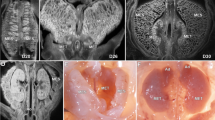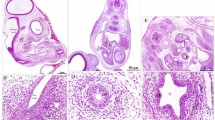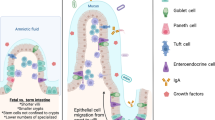Abstract
The structure and composition of fetal and placental tissues vary among different species of placental mammals. Some mammals, including camelids and pigs, possess an epidermal membrane during the fetal stage, called the epithelion, that is absent from other domestic mammals. Because neonatal piglets are a common animal model for many research techniques, it is important that researchers correctly identify this tissue and recognize its lack of pathological consequence when working with fetal and neonatal piglets. Here, the authors describe gross and histological examinations of the epithelion, comparing this tissue with other extra-fetal tissues and coatings.
This is a preview of subscription content, access via your institution
Access options
Subscribe to this journal
We are sorry, but there is no personal subscription option available for your country.
Buy this article
- Purchase on Springer Link
- Instant access to full article PDF
Prices may be subject to local taxes which are calculated during checkout




Similar content being viewed by others
References
King, G.J. Comparative placentation in ungulates. J. Exp. Zool. 31, 588–602 (1982).
Friess, A.E., Sinowatz, F., Skolek-Winnisch, R. & Trautner, W. The placenta of the pig. I. Finestructural changes of the placental barrier during pregnancy. Anat. Embryol. 158, 179–191 (1980).
Fowler, M.E. Medicine and Surgery of Camelids. 3rd edn. (Wiley-Blackwell, Hoboken, NJ, 2010).
Musa, B.E. A new epidermal membrane associated with the foetus of the camel (Camelus dromedarius). Zb. Vet. Med. C Anat. Histol. Embryol. 6, 355–358 (1977).
Morton, W.R.M. Observations on the full term foetal membranes of the three members of the Camelidae (Camelus dromedaries L., Camelus bactrianus L., and Lama glama L.). J. Anat. 95, 200–209 (1961).
Schmied, J., Rupa, P., Garvie, S. & Wilkie, B. Immune response phenotype of allergic versus clinically tolerant pigs in a neonatal swine model of allergy. Vet. Immunol. Immunop. 154, 17–24 (2013).
Luo, X. et al. Effects of microporous porcine acellular dermal matrix combined with bone marrow mesenchymal cells of rats on regeneration of cutaneous apendages cells in nude mice. Zhongua Shao Shang Za Zhi 6, 541–547 (2013).
Bistoni, G. et al. Prolongation of skin allograft survival in rats by the transplantation of microencapsulated xenogeneic neonatal porcine Sertoli cells. Biomaterials. 33, 5333–5340 (2012).
Brunton, J.A., Baldwin, M.P., Hanna, R.A. & Bertolo, R.F. Proline supplementation to paternal nutrition results in greater rates of protein synthesis in the muscle, skin, and small intestine in neonatal Yucatan miniature piglets. J. Nutr. 142, 1004–1008 (2012).
Rauma, M. & Johanson, G. Comparison of the thermogravimetric analysis (TGA) and Franz cell methods to assess dermal diffusion of volatile chemicals. Toxicol. In Vitro 5, 919–926 (2009).
Bressan, F.F. et al. Unearthing the roles of imprinted genes in the placenta. Placenta 30, 823–834 (2009).
Sinclair, J.G. Anatomy of the Fetal Pig (Collegiate Press, Ames, Iowa, 1936).
Author information
Authors and Affiliations
Corresponding author
Ethics declarations
Competing interests
The authors declare no competing financial interests.
Rights and permissions
About this article
Cite this article
Pearson, J., Smith, M. & Schlafer, D. Gross and histological description of the epidermal membrane found on normal neonatal piglets. Lab Anim 44, 445–447 (2015). https://doi.org/10.1038/laban.890
Received:
Accepted:
Published:
Issue Date:
DOI: https://doi.org/10.1038/laban.890



